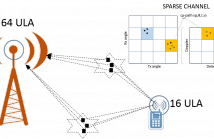
- Read more about Robust Artificial-Noise Aided Transmit Design for Multi- User MISO Systems with Integrated Services
- Log in to post comments
This paper considers an optimal artificial noise (AN)-aided transmit design for multi-user MISO systems in the eyes of service integration. Specifically, two sorts of services are combined and served simultaneously: one multicast message intended for all receivers and one confidential message intended for only one receiver. The confidential message is kept perfectly secure from all the unauthorized receivers.
- Categories:
 18 Views
18 Views- Read more about ACHIEVING GLOBAL OPTIMALITY FOR WIRELESSLY-POWERED MULTI-ANTENNA TWRC WITH LATTICE CODES
- Log in to post comments
poster.pdf
- Categories:
 6 Views
6 Views- Read more about Opportunistic Beam Training with Hybrid Analog/Digital Codebooks for mmWave Systems
- Log in to post comments
- Categories:
 32 Views
32 Views- Read more about Multi-User MIMO-OFDM for Indoor Visible Light Communication Systems
- Log in to post comments
- Categories:
 8 Views
8 Views
- Read more about Multi-Linear Subspace Estimation and Projection for Efficient RFI Excision in SIMO Systems
- Log in to post comments
The document presents the multi-linear algebra framework to the RFI excision research by proposing a multi-linear subspace estimation and projection (MLSEP) algorithm for efficient RFI excision in single-input multiple-output (SIMO) systems.
- Categories:
 9 Views
9 Views- Read more about Channel Estimation Using Joint Dictionary Learning in FDD Massive MIMO Systems
- Log in to post comments
In a frequency division duplex (FDD) massive MIMO system, downlink channel estimation poses several challenges with limited training duration being one impediment. Our previous work developed an algorithm to learn a dictionary in which the channel can be sparsely represented, and then leveraged compressed sensing framework to estimate the downlink channel. In this work, we extend the sparse channel representation framework to joint uplink and downlink channel modeling exploiting the similar scattering environment experienced by the signal during uplink and downlink transmission.
- Categories:
 34 Views
34 Views- Read more about Radar Precoding for Spectrum Sharing Between Matrix Completion Based MIMO Radars and A MIMO Communication System
- Log in to post comments
The paper investigates a new framework for spectrum sharing between a MIMO-MC radar (MIMO radar using matrix completion) and a MIMO communication system, based on radar transmit precoding. The radar transmit precoder is jointly designed with the communication codewords so that the SINR at the radar receiver is maximized while meeting certain rate and power constraints at the communication system. By shaping the transmit beam, the proposed approach results in enhanced SINR at the receive antennas.
- Categories:
 14 Views
14 Views
- Read more about Leveraging Sparsity into Massive MIMO Channel Estimation with the A-LASSO
- Log in to post comments
Recent channel measurement campaigns have revealed that at high carrier frequencies (10GHz and above) MIMO channels exhibit sparsity structure, i.e., a few dominant propagation paths and, in some cases, it can also reduce to a single path, yet very directive, wireless channel. In this work, we leverage the sparsity feature into the development of sparse-MIMO channel estimator and show, how an adaptive l1-optimization method can greatly improve the estimation error.
- Categories:
 42 Views
42 Views- Read more about Effect of Noise Variance Estimation on Channel Quality Indicator in LTE Systems
- Log in to post comments
EffectNV.pdf
- Categories:
 10 Views
10 Views